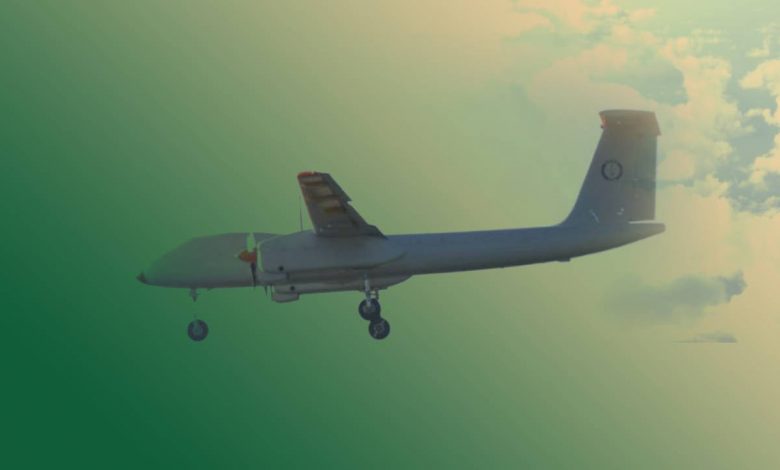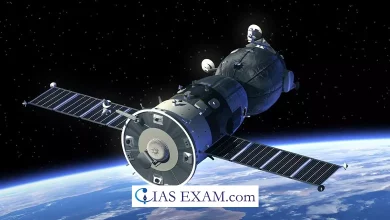Daily Current Affairs for UPSC
UAV Rustom-2

Topic- Defence Technology [GS Paper-3]
Context- The indigenous medium altitude long endurance (MALE) unmanned aerial vehicle (UAV), Rustom-2 developed by the Defence Research and Development Organisation (DRDO) is expected to complete all user trials by August 2023.
Key Highlights
- The DRDO is likely to launch the UAV Rustom-2 by 2023.
- At the same time a separate project for the weaponisation of the Rustom UAV is also under way.
- Currently Four prototypes of Rustom-2 are already flying.
- Whereas Five production models to be manufactured by Hindustan Aeronautics Ltd. (HAL), which is the production partner of DRDO.
- The flying trials of Rustom-2 had started but were held up due to logistical issues and were expected to be completed shortly.
- During the last trial Rustom-2 had crossed a milestone by reaching an altitude of 25,000 feet and an endurance of 10 hours.
- The target of the UAV is to reach an altitude of 30,000 feet with an endurance of 20 hours, which has to be demonstrated.
- Rustom-2 technologically matched the contemporary UAVs available and it would also be cheaper than the imported ones while meeting the requirements of the three Services.
UAV Rustom
- Rustom is a Medium Altitude Long Endurance unmanned air vehicle (UAV) which is developed by Defence Research and Development Organisation for the three services, Indian Army, Indian Navy and the Indian Air Force of the Indian Armed Forces.
- The basic design for India’s UAV Rustom is derived from the NAL’s LCRA (Light Canard Research Aircraft) developed by a team under the leadership of late Prof Rustom Damania in the 1980s.
- The UAV Rustom will replace and supplement the Heron UAVs in service with the Indian armed forces.
- With the Rustom MALE UAV project, DRDO targets to move away from traditional ways of developing products whereby laboratories under DRDO, like the Aeronautical Development Establishment (ADE), which is involved in this project, develop and finalize the product and transfer technology to a production agency.
- There are in total five UAVs developed by the DRDO in this category i.e.
- Rustom-1- launched on 11 November 2009
- TAPAS-BH-201- launched on 15 November 2016
- Rustom-1 UAV
- Rustom-H MALE UAV
- TAPAS-BH-201 (Rustom-2) MALE UAV
Rustom Variants
- Rustom-1 has a wingspan of 7.9 m i.e. 26 ft and weighs 720 kg (1,590 lb), will be launched by the conventional method and not the launcher as in the case of the DRDO Lakshya.
- Rustom-1 has been enabled to see the enemy territory up to a distance of 250 km (160 mi) and carry a variety of cameras and radar for surveillance.
- Whereas Rustom-H, is built on a different design and it is a Medium-Altitude Long-Endurance (MALE) Unmanned Aerial Vehicle (MALE UAV), a twin engine system designed to carry out surveillance and reconnaissance missions. Rustom H will have a payload capacity of 350 kg (770 lb).
- The range of advanced technologies and systems available in the Rustom is
- Aerodynamic configurations, High aspect ratio wing, Composite airframe integrated with propulsion system, De-icing system for wings
- Highly reliable systems with built-in redundancy for flight critical systems like flight control and navigation, data links, power management, – and mission critical payload management system
- Digital Flight Control and Navigation System, Automatic Take off and Landing (ATOL)
- Digital communication technologies for realizing data links to control and operate the mission and relay UAVs
- Payloads with high resolution and precision stabilized platforms.
Significances of Rustom-2
- High endurance UAVs like Rustom-2 are a priority requirement for the Indian armed forces especially in view of the stand-off with China in eastern Ladakh.
- Also as the Indian armed forces rely heavily rely on Israeli Searcher and Heron drones to meet their requirements and they have need for more such UAVs and the Services have embarked on a major upgrade project of the Heron UAVs in use.
Unmanned Aerial Vehicle (UAV)
- Unmanned aerial vehicles (UAVs), are drones or aircraft which are either controlled by ‘pilots’ from the ground or increasingly, autonomously following a pre-programmed mission.
- There are three subsets of Unmanned Aircraft i.e. Remotely Piloted Aircraft, Autonomous Aircraft and Model Aircraft.
Medium-Altitude Long-Endurance (MALE)
- MALE refers to an Unmanned Aerial Vehicle (UAV) that flies at an altitude window of 10,000 to 30,000 feet for extended durations of time, typically 24 to 48 hours.





.png)



